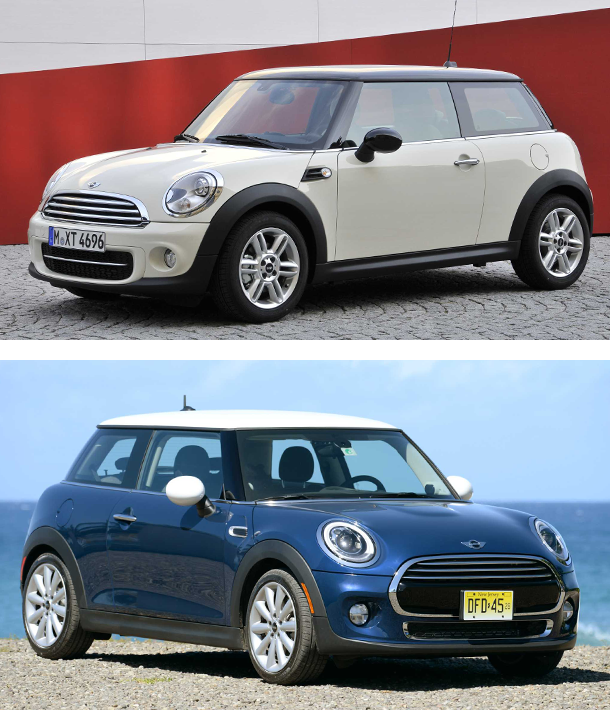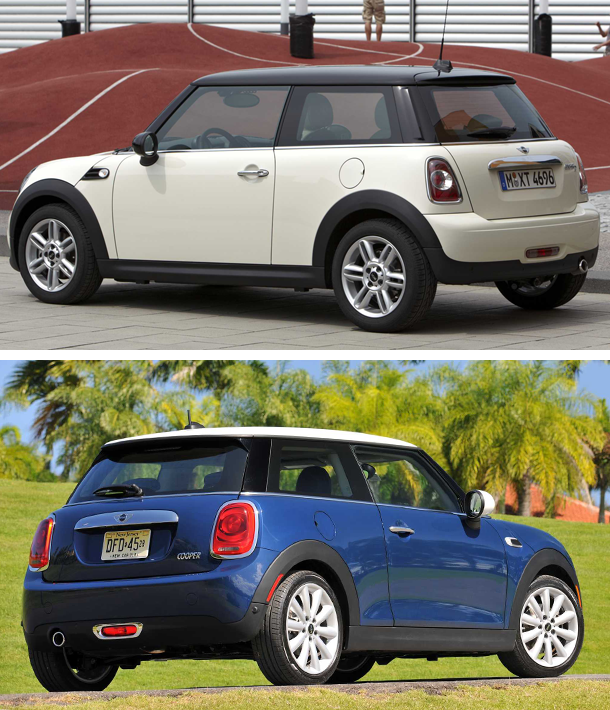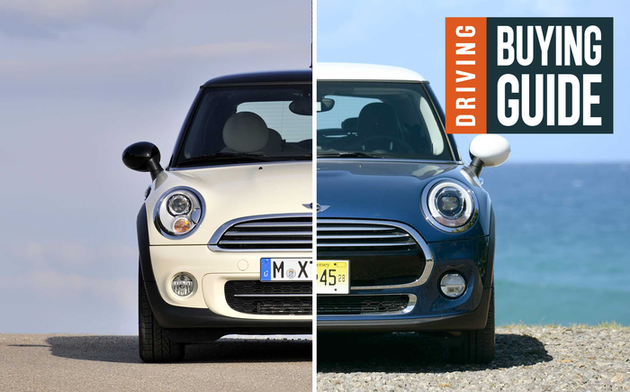Buying guide: 2014 Mini Mk 3 v Mini Mk 2 – how do they differ?
Mini squared
WE ALL know that the Mini actually stopped being mini when it was relaunched in 2001. It grew again in 2006 with the Mk 2 and if you caught Andrew Frankel’s first-drive review of the 2014 Mini Cooper hatchback, you’ll know the latest generation is even bigger still.
But size isn’t everything, ladies and gentlemen. What else has changed? Is it worth forking out for the Mk 3, or should you save some cash and go with a used Mk 2? Here we present our buyer’s guide.
Mini Mk 2 vs Mk 3: The exterior

As we said, the new Mini has grown in size over the old model. It’s now 98mm longer, 44mm wider and 7mm taller. The wheelbase (the distance between the centre of the front wheels and the centre of the rear wheels) has also increased, by 28mm, as has the track (the distance between the opposing wheels), by 42mm at the front and 34mm at the rear. The result is four wheels that are further apart than ever, which should mean more interior space and extra stability (but scroll down for notes on both these things).
Mini’s press notes state that the car is lighter in most formats, but the specification sheets tell another story. The new car is mildly heavier in all cases. The 2014 Mini Cooper, for example, weighs 1160kg, compared with 1150kg for the Mk 2. When we contacted Mini, a spokesperson confirmed our figures were correct.
Take a look at the Minis available to buy used and nearly new on driving.co.uk – click here
In terms of body design, the change from Mk 2 to Mk 3 is more evolution than revolution. The radiator grille is now hexagonal in shape and spans the bumper rather than being split above and below, while the headlights are revised. The optional LED headlamps include a daytime “driving ring” around the top of the main light, with an integrated indicator strip below. The rear of the car has had only a modest tweak, notably to the light clusters.

Overall, though, Mini has managed to make the new car more aerodynamic with the drag coefficient now down to 0.28 (or 0.31 for the Mini Cooper S).
Significantly, when the new car arrives in March, it will be available only as a three-door hatchback. The Clubman “estate” will have five doors not four, having lost the single rear “suicide door”. It won’t arrive before the end of the year.
Mini Mk 2 vs Mk 3: The interior

Inside, the biggest change to the Mk 3 is that the massive speedometer, previously mounted centrally in the dashboard, has been moved to the more conventional position behind the steering wheel. This may disappoint Mini fans as it could be seen as conformist, but it is certainly a more practical location.
The central spot on the dash is now dedicated to navigation, entertainment and communication displays. As standard, the central display is a 4-line TFT, or else an optional colour display up to 8.8in in size. The newly structured Mini Connected infotainment system uses apps, allowing for continual expansion and upgrade. It means you can tweet from the car, browse Facebook, access foursquare and Glympse, receive RSS newsfeeds and entertainment features such as AUPEO!, Stitcher, Deezer, Audible, Napster/Rhapsody and TuneIn. We’ll pretend to know what all that means.
A coloured lighting configuration includes an LED ring for, “visual feedback in response to numerous operating functions”, says Mini.
In terms of comfort, there’s a new seat design, as well as increased front seat adjustment.
In the rear, the car’s increased dimensions have paid dividends. The seat squabs are longer by 23mm, and there’s more shoulder and leg room. Luggage volume has increased by 51 litres to a modest 211 litres.
Mini also claims increased acoustic and vibrational comfort on the 2014 model.
Mini Mk 2 vs Mk 3: Engines and performance

As you might expect, Mini has used new technology to improve both the performance and the efficiency of the new model’s engine line-up. All but the Cooper S now have smaller, lighter, three-cylinder engines, and all use Mini’s TwinPower Turbo Technology (the old Mini One and Cooper had naturally aspirated – or non-turbo – units).
The biggest efficiency advance can be found in the Mini Cooper with automatic transmission: acceleration from 0- 62mph is 2.6 seconds quicker, but average fuel consumption is 27% lower.
As before, a six-speed manual transmission is standard, with an optional six-speed automatic transmission or sports automatic transmission available. All are newly developed. When Driving’s Andrew Frankel took the Cooper S for a spin, he said the new manual ’box “has such a light, precise and quick change, you’ll be flicking through the gears just because you can”.
The new Mini features variable vehicle set-up using the new Driving Modes option by means of a rotary switch at the base of the gearshift, or selector lever. In addition to the standard “Mid” mode, “Sport” and “Green” modes can be activated. The choice of mode influences the steering feel, throttle response, automatic transmission shift timings and the Dynamic Damper Control, where these features are fitted.
Specification details
|
Variant |
New Mini (Mk 3) |
Mini (Mk 2) |
| MINI Cooper S | Engine: 1,998cc, 4-cylinder turboPower: 192bhp @ 4,700- 6,000rpmTorque: 207lb ft @ 1,250-4,750 rpmAcceleration: 0-62mph in 6.8secTop speed: 146mphFuel: 49.6mpgCO2: 133g/km | Engine: 1,598cc, 4-cylinder turboPower: 184bhp @ 5,500rpmTorque: 177lb ft @ 1,600-5,000 rpmAcceleration: 0-62mph in 7secTop speed: 142mphFuel: 48.7mpgCO2: 136g/km |
| MINI Cooper | Engine: 1,499cc, 3-cylinder turboPower: 136bhp @ 4,500-6,000rpmTorque: 162lb ft @ 1,250-4,000rpmAcceleration: 0-62mph in 7.9secTop speed: 130mphFuel: 62.8mpgCO2: 105g/km | Engine: 1,598cc, 4-cylinder (NA)Power: 122bhp @ 6,000rpmTorque: 118lb ft @ 4250rpmAcceleration: 0-62mph in 9.1 secTop speed: 126mphFuel: 52.3mpgCO2: 127g/km |
| MINI One | Engine: 1,233cc, 3-cylinder turboPower: 102bhp @ 4,250-6,000rpmTorque: 133lb ft @ 1,400-4,000rpmAcceleration: 0-62mph in 9.9secTop speed: 121mphFuel: 61mpgCO2: 108g/km | Engine: 1,598cc, 4-cylinder (NA)Power: 98bhp @ 6,000rpmTorque: 113lb ft @ 3,000rpmAcceleration: 0-62mph in 10.5secTop speed: 116mphFuel: 52.3mpgCO2: 127g/km |
| MINI Cooper D | Engine: 1,496cc, 3-cylinder turboPower: 116bhp @ 4,000rpmTorque: 199lb ft @ 1,750rpmAcceleration: 0-62mph in 9.2secTop speed: 127mphFuel: 81mpgCO2: 92g/km | Engine: 1,598cc, 4-cylinder turboPower: 112bhp @ 4,000rpmTorque: 199lb ft @ 1,750-2,250rpmAcceleration: 0-62mph in 9.7secTop speed: 122mphFuel: 74.3mpgCO2: 99g/km |
| MINI One D | Engine: 1,496cc, 3-cylinder turboPower: 95bhp @ 4,000rpmTorque: 162lb ft @ 1,496rpmAcceleration: 0-62mph in 11sectop speed: 118mphFuel: 83mpgCO2: 89g/km | Engine: 1,598cc, 4-cylinder turboPower: 90bhp @ 4,000rpmTorque: 158lb ft @ 1,750-2,500rpmAcceleration: 0-62mph in 11.4secTop speed: 114mphFuel: 74.3mpgCO2: 99g/km |
Mini Mk 2 vs Mk 3: Handling

Mini says the Mk 3’s suspension has been extensively revised and the car now features increased rigidity and lighter, smaller components. We found the new Mini to be softer than the outgoing model, however. But this is a good thing according to our tester, who said the new Cooper S is “still firm but [it] has lost the skittishness and no longer jumps about over bumps and potholes.”
Of the new Mini Cooper, with its 3-cylinder engine, he said, “Turn the steering wheel and it goes exactly where you want it to, perhaps not quite as sharply as before but enough to reassure you that nothing has been lost in the handling.”
Conclusion
With its kart-like feel the Mini is still best-in-class for enjoyment behind the wheel, while the new range of engines add increased speed and economy, with lower running costs.
However, the Mk 2 is a little stiffer and lighter, and arguably offers a better connection between driver and vehicle – in other words, the old model can be considered a more rewarding drive for purists. And, with the new model on the way, you’re sure to be able to find discounts on the outgoing car.
Take a look at the Minis available to buy used and nearly new on driving.co.uk – click here





